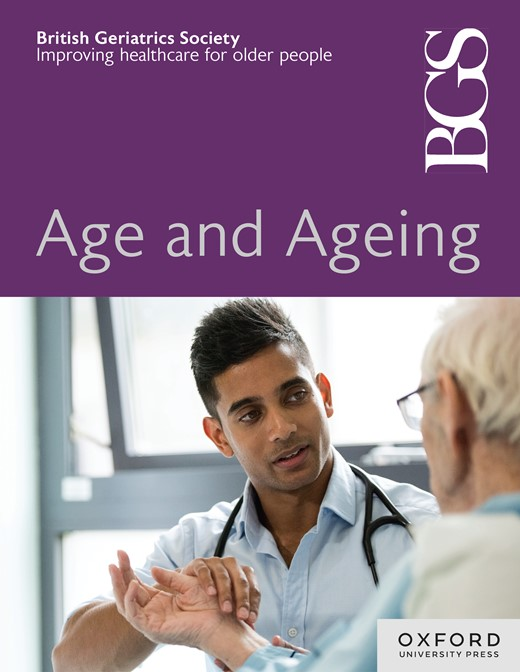作为急诊入院治疗一部分的谵妄评估和记录
IF 6
2区 医学
Q1 GERIATRICS & GERONTOLOGY
引用次数: 0
摘要
背景谵妄是影响急症医院老年患者的一个普遍问题。国家指导方针规定,所有入住急症医院的 65 岁患者都必须接受谵妄筛查。及时评估和处理谵妄对于为老年患者提供最佳护理至关重要。在我们医院,谵妄可能未得到充分认识,也没有作为医疗入院的一部分进行常规评估。我们的目的是评估谵妄的记录率,并在服务开发项目中将 4AT 作为急性病入院治疗的一部分。方法 我们对 2023 年 1 月、2 月和 3 月入院患者的人口统计学特征、谵妄记录和 4AT 进行了回顾性评估,并与 2024 年新设老年病专科病房(SGW)后的 3 个月同期进行了比较,这是服务发展项目的一部分。与此同时,还采取了有针对性的干预措施,以改善谵妄的教育和管理。结果 两组患者的平均年龄均为 83 岁。在设立 SGW 之前和设立 SGW 之后,分别有 11% (18/157)和 30% (40/134)的患者被诊断患有痴呆症。入院前,13%(20/157)的患者在入院记录中记录有谵妄,入院后,23%(31/134)的患者在入院记录中记录有谵妄。设置 SGW 后,24%(32/134)的患者在入院记录中记录了 4AT 诊断,而之前只有 6%(10/157)的患者在入院记录中记录了 4AT 诊断。结论 急诊入院记录中对 4AT 和谵妄的记录不够理想。我院正在开发并实施一种急性病入院病历,其中将包括 4AT 谵妄筛查工具。我们将在 6 个月后对此进行重新评估,以确定在谵妄和 4AT 记录方面是否有所改进。我们还将对负责入院的非物质文化遗产医疗小组进行教育,强调使用 4AT 和谵妄记录的重要性。本文章由计算机程序翻译,如有差异,请以英文原文为准。
Delirium Assessment And Documentation As Part Of An Acute Medical Admission
Background Delirium is a prevalent issue affecting older patients in acute hospitals. National guidelines mandate that all patients >65 years old admitted to an acute hospital setting are screened for delirium. Prompt assessment and management of delirium is vital in delivering optimal care to the older patient. In our institution, delirium can be under recognised and not assessed routinely as part of the medical admission. Our aim was to assess delirium documentation rates and utilising the 4AT as part of the acute medical admission in a service development project. Methods A retrospective assessment of patient demographics and documentation of delirium and 4AT in the medical admission was carried out for January, February and March 2023 and compared to the same 3-month period in 2024 post set up of a new specialist geriatric ward (SGW) as part of a service development project. This was in tandem to targeted interventions for improving delirium education and management. Results Mean age was 83 years in both groups. 11% (18/157) in the cohort pre SGW and 30% (40/134) post setup of the SGW had a diagnosis of dementia. 13% (20/157) in the pre SGW cohort had delirium documented in the admission note and 23% (31/134) post. 24% (32/134) had a 4AT documented in the admission note post SGW setup compared with 6% (10/157) previously. Conclusion There was suboptimal documentation of the 4AT and delirium in the acute medical admission note. An acute medical admission proforma is being developed and implemented in our institution which will include a 4AT delirium screening tool. We will reassess this in 6 months’ time to ascertain whether there is an improvement in delirium and 4AT documentation. We will also give education to the medical NCHD group carrying out the admissions to emphasise the importance of utilising the 4AT and delirium documentation.
求助全文
通过发布文献求助,成功后即可免费获取论文全文。
去求助
来源期刊

Age and ageing
医学-老年医学
CiteScore
9.20
自引率
6.00%
发文量
796
审稿时长
4-8 weeks
期刊介绍:
Age and Ageing is an international journal publishing refereed original articles and commissioned reviews on geriatric medicine and gerontology. Its range includes research on ageing and clinical, epidemiological, and psychological aspects of later life.
 求助内容:
求助内容: 应助结果提醒方式:
应助结果提醒方式:


